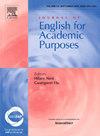学生出于学术目的使用机器翻译和生成人工智能工具的自主权
IF 3.4
1区 文学
Q1 EDUCATION & EDUCATIONAL RESEARCH
引用次数: 0
摘要
机器翻译(MT)和生成式人工智能(GAI)的兴起为学术英语(EAP)教学带来了机遇和挑战。虽然MT/GAI可以支持学生在课堂之外的学习,但过度依赖MT/GAI可能会阻碍基本研究和写作技能的发展。尽管有一些关于MT/GAI在自我调节学习中的作用的研究,但对学生使用MT/GAI的动机以及教学情境和学科的潜在中介影响知之甚少。本研究运用自我决定理论来研究自主性、能力和相关性如何影响学生在学术写作中使用MT/GAI。该研究采用混合方法,比较了澳大利亚英语作为第二语言环境和越南英语作为外语环境下EAP学生的情况。通过验证性因子分析和判别效度测试验证的在线调查收集了416份回复,并辅以对17名学生的访谈。研究结果揭示了MT/GAI使用与学生动机需求之间复杂的相互作用。虽然在调查中,学生普遍报告在使用MT/GAI方面有适度的自主性、能力和相关性,但混合效应回归显示,与越南学生相比,澳大利亚学生的相关性较低,学科差异也显著影响学生对这一结构的看法。访谈数据进一步强调了学生认知的多样性和复杂性、EAP教学方法的差异以及围绕MT/GAI的同伴-教师动态。这些发现支持需要根据具体情况量身定制教学方法,促进机构、教师和学生之间的合作,这一点通过澳大利亚EAP课程的创新来说明,该课程在MT/ ai辅助学术写作的研究和实践之间建立了桥梁。本文章由计算机程序翻译,如有差异,请以英文原文为准。
Students’ self-determination in using machine translation and generative AI tools for English for academic purposes
The rise of machine translation (MT) and generative artificial intelligence (GAI) presents opportunities and challenges for English for Academic Purposes (EAP) instruction. While MT/GAI can support students' learning beyond the classroom, overreliance on MT/GAI may hinder development of essential research and composition skills. Despite some research on MT/GAI's role in self-regulated learning, little is known about students' motivations for its use, and the potential mediating influences of instructional context and discipline. This study applies Self-Determination Theory to examine how autonomy, competence, and relatedness influence students' use of MT/GAI in academic writing. Using a mixed-methods approach, the study compares EAP students in an English as a Second Language context in Australia and an English as a Foreign Language context in Vietnam. An online survey validated through confirmatory factor analysis and discriminant validity testing gathered 416 responses, complemented by interviews with 17 students. Findings reveal a complex interplay between MT/GAI use and students' motivational needs. While students generally report moderate autonomy, competence, and relatedness in using MT/GAI in the survey, mixed-effects regression showed Australian students experienced lower relatedness compared with Vietnamese students, with disciplinary differences also significantly influencing students' perceptions of this construct. Interview data further highlighted diversity and complexity of students' perceptions, variation in EAP instructional approaches and peer-teacher dynamics surrounding MT/GAI. These findings support the need for contextually tailored pedagogical approaches fostering collaboration between institutions, teachers, and students, illustrated through innovations from an Australian EAP course that bridge research and practice in MT/GAI-assisted academic writing.
求助全文
通过发布文献求助,成功后即可免费获取论文全文。
去求助
来源期刊

Journal of English for Academic Purposes
Multiple-
CiteScore
6.60
自引率
13.30%
发文量
81
审稿时长
57 days
期刊介绍:
The Journal of English for Academic Purposes provides a forum for the dissemination of information and views which enables practitioners of and researchers in EAP to keep current with developments in their field and to contribute to its continued updating. JEAP publishes articles, book reviews, conference reports, and academic exchanges in the linguistic, sociolinguistic and psycholinguistic description of English as it occurs in the contexts of academic study and scholarly exchange itself.
 求助内容:
求助内容: 应助结果提醒方式:
应助结果提醒方式:


